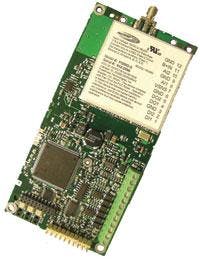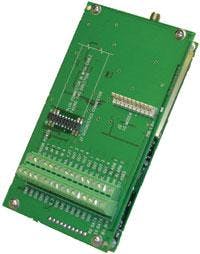Dan Paladino
Dan Paladino of the US company FreeWave Technologies, Inc. debunks the myths and urban legends circulated about Spread Spectrum radio technology in the water and wastewater industry, and provides a better understanding of its correct applications.
Misconceptions and misunderstandings of any new technology always surface when first introduced into an industry. Spread Spectrum communication system providers face the same challenge.
The wireless IO product FGRIO (slave) is manufactured by FreeWave Technologies, Inc.
The water and wastewater industry is deploying more Spread Spectrum communication solutions every year. And like any technology, it can be an extremely valuable tool when used in the correct environment and with correct deployment. Five years ago data telemetry was almost exclusively in the licensed radio realm; however Spread Spectrum radio has become an increasingly popular choice given the scarcity of available licensed channels and advances made in this technology.
Originally designed for security purposes, Spread Spectrum was invented for the US Navy during World War II to prevent the Germans from “jamming” American radio transmissions for radio-guided torpedoes. The first system used only 88 frequencies. Today, the switching is controlled in embedded software code that enables a radio to change frequencies in excess of 200 times per second and use more than 100 channels.
The technology behind Spread Spectrum radio is complex enough that anyone trying to intercept a signal would have to match more than 186,000 possible parameters to be on the same channel with the radio and then would only be in sync for about 1/100th or possibly 1/200thof a second. In addition to matching parameters, the entity attempting to intercept data would find that today’s Spread Spectrum radios also use advanced encryption protocol to insure additional security.
FreeWave Technologies also manufactures the wireless IO Master transmitter
The common fear is that as more companies go to this “shared” frequency, it will become saturated and unusable. However, if there is a saturation point, it has not yet been reached. In many areas of the USA, thousands of Spread Spectrum radios delivering data to multiple end-users without conflict or data loss. Considerable research and development has gone into developing Spread Spectrum radios that can work in close proximity to one other and share the same frequency bands. To accomplish this goal, radio networks are programmed to share common bands, but use separate frequencies. Each radio network is programmed to “hop” to a different frequency than the other radio networks in the area. This hopping allows users to build distinct communication networks that will not conflict with other networks in the immediate area.
Another common myth is that Spread Spectrum is good only for short-range communication; however it can be deployed as a complete (long-range and short-range) communication network solution. This technology is a result of the lower maximum output power of a Spread Spectrum radio. By US federal regulation, a Spread Spectrum radio can only have an output of one Watt of radiated power at the radio and four Watts at the antenna. Licensed radios, by contrast, can have higher output power, typically five Watts at the radio and 20 Watts at the antenna. In a contest of which radio will broadcast the furthest in a straight line, the licensed radio will clearly win the distance contest, however it is extremely rare to have a line of sight range exceed 20 miles. Typically, an obstruction such as a building, valley, hill, or vegetation will interrupt a signal in longer-range applications. Spread Spectrum radios can easily establish links of 20 miles and they have even been able to link at distances greater than 60 miles. These radios have been used for data links between offshore platforms in the Gulf of Mexico where the platforms were more than 30 miles apart. In order to establish a 30-mile link in this application, the end user had to have radio antennas mounted at least 100 feet above the water to compensate for the curve of the earth.
An additional factor influencing complete long-range communication is repeaters. A licensed radio system can only have one repeater in a network. All slave sites must communicate to either the Master unit directly or though a maximum of one repeater. Spread Spectrum technology allows multiple repeaters. These repeaters can either be arranged in series (serial repeater) to extend the range or in parallel to improve coverage around obstacles such as hills, buildings, or vegetation. It is also possible to mix repeaters in parallel and series to provide the benefit of all capabilities in large systems. Some manufacturers produce products where the use of repeaters is unlimited, meaning there are no limits to the number of repeaters you can have in a single network. Some complex networks actually use more than 100 repeaters in a single network.
Another feature offered by a limited number of manufacturers is the ability to have the radio to operate as a slave and repeater simultaneously. This feature provides both a network extended capability and a cost reducing tool. The slave/repeater function eliminates the need for multiple dedicated repeaters while also reducing installation costs. The “magic” here is that any PLC (programmable Logic Controller), RTU (Remote Terminal Unit), or EFM (Electronic Flow Meter) site can multitask as both a slave unit, sending data back to the host and as a repeater for other devices further down the network hierarchy.
Spread Spectrum radio systems can track and control water purification and/or delivery systems for hundreds of miles using a wireless “daisy chain” to bring data through a series of repeaters back to the host in a distant location.
Many people believe that if they install a base of licensed radios, they must use the same manufacturer and model of radio they originally purchased. Fortunately, Spread Spectrum radios can be used with an existing licensed radio system to reduce costs and facilitate multiple repeaters. This network can be accomplished by placing a new repeater in the existing system. An existing licensed slave site can be placed back-to-back with a Spread Spectrum (Master) radio and join the two radios together by using a “Null Modem” cable between their respective RS-232 ports.
When the licensed master transmits to the licensed slave, the request is passed through the licensed slave’s RS 232 port to the Spread Spectrum radio’s RS 232 port. The Spread Spectrum Master will then retransmit the message to the Spread Spectrum “network extension” downstream from the Spread Spectrum master. This hybrid system offers many advantages over any single system network.
Hybrid systems can be created by combining CDPD (Cellular Digital Packetize Data), Satellite, Cell Phones, and landline telephone modems individually with Spread Spectrum. The beauty of these systems is that the end user can use a communication device, such as a landline, to cover a long distance of 100 miles and then “mate” to a Spread Spectrum network to gather data over a wide area network (WAN). This configuration would allow an end-user to gather data from 100 devices through a single telephone connection.
A common misconception is that Spread Spectrum and other radio communications will interfere with each other. The most common Spread Spectrum band in the United States is 902 Megahertz to 928 Megahertz. The US federal government set this frequency band aside to be allocated for Spread Spectrum devices and the rules are structured to allow the band to be shared by multiple users. The official designation for this band is ISM, which implies this was established for Industrial, Scientific, and Medical usage. Licensed radios use frequencies outside of this band.
The closest frequencies to the ISM bands 902 Megahertz to 928 Megahertz range are cell phones and microwave signals. If the power of one of these two communication devices is high enough and the device is not precisely tuned to its licensed frequency, it is possible for the signal to “bleed over” into the ISM band. The cure for this occurrence is an inexpensive Band Pass Filter. This filter will block any noise or interference that is outside the 902 MHz to 928 MHz range.
Many times you might hear that radios must have clear “Line of Sight” (LOS). It is also a common myth that Spread Spectrum radios are more restricted by line of sight than other communications devices. Spread Spectrum radios will indeed pass data through obstacles such as buildings, trees, and in many cases over hills but a radio signal in these environments introduces “attenuation” into the signal path. Attenuation is a resistance that reduces the strength of the signal.
Radio signals will often transmit through buildings, but not through both a building and then a distance of 20 miles. Spread Spectrum radios are used to gather data from multiple floors in a building and bring it to a central collection point in the basement or lowest level. After some finite number of floors, the signal will become so weak that it will not penetrate any more floors. Even in this case, the radio may sometimes find a path (elevator shafts) that allows the signal to continue. This illustrates an example in which there is no clear “Line of Sight” for the transmitted signal, yet the signal still reaches its destination.
A radio will communicate through multiple floors depending on the environment and the antennas being used. The common term for this degradation of signal is “Path Loss” or “Signal Fade”, which can be computed by software programs. Performing a path study prior to starting a project will create a network design that insures a solid robust communication system, regardless of line of sight in the area.
Author’s Note
Dan Paladino of the US company FreeWave Technologies, Inc. is based in Boulder, Colorado.
Spread Spectrum and Ethernet trends gain momentum
Spread Spectrum is a relatively new technology for data communication that can be used in almost any data acquisition system that would work with licensed radio, but Spread Spectrum systems are dramatically different from licensed systems. The use of multiple repeaters and slave/repeaters allows for long-range, flexible, and secure networks. And the option of hybrid communication allows users to match the “best fit” for their data network.
Spread Spectrum radios can reduce communication costs while increasing the reliability and throughput of any system. Only a few years ago, radio systems commonly used Bell 202 modems and a 1200-baud throughput. Spread Spectrum radios now deliver data at speeds up to 115 K-baud. Speed and error-free results, accomplished by using CRC up to 32-bit, provide a viable communication option for applications never before thought to be within the realm of wireless communication.
The natural evolution of data communications has brought us to understand the benefits of Spread Spectrum radios and the power of their versatility. Spread Spectrum’s ability to be coupled with other communication mediums adds yet another layer of versatility that makes it reasonable to foresee the day when these radios and their closest relative, the Ethernet radio, will become the dominant communication device in data collection.
US municipalities adopt wireless IO solutions
Wireless technology is becoming increasingly popular with many US municipal water companies, serving as the information link from water sensor sites to the desktop.
Not so long ago, the most common application for wireless radios was supervisory, control and data acquisition (SCADA) systems. SCADA entails any clean or waste water system that uses control devices, wireless or wired. These systems ensure that pumps are functioning, tanks are at appropriate levels and wastewater is flowing in the right direction.
Along with the surge in wireless installations, wireless IO applications are also expected to grow. Typically, water tanks and gauges-tank gauges, temperature sensors or pressure transducers-do not communicate serially at certain locations. Until recently, the only way to communicate with this equipment was to string wire (either buried or overhead) from the monitoring device to the RTU (Remote Terminal Unit). Such activities are often labor-intensive, time-consuming and expensive. Wireless IO systems help end users overcome these difficulties by eliminating many labor costs and safety hazards associated with trenching. Wireless IO systems can be installed without waiting to schedule machinery and electricians and can be installed easily by on-site technicians.
The wireless IO system is a totally wireless sensor monitoring solution composed of wellhead intelligence, desktop intelligence, wireless communication and wireless end devices. The IO system replaces wire, trenching and conduit and can remotely monitor and relay data for pressure, temperature, level and flow. It can also open and close valves and monitor alarms in any water
The wireless IO is useful for data transmission in water and wastewater locations for monitoring chlorine and tank levels; pump shut down; chemical injection monitoring; valve control; and temperature and pressure monitoring; and sensors for homeland security.
Wireless IO will work in many situations:
• Across a river, pipelines, streams or wetland site;
• Offshore;
• Substation automation;
• Across a highway;
• Inside factories and plants where it would be cost prohibitive to run conduit and trenching is not an option.




